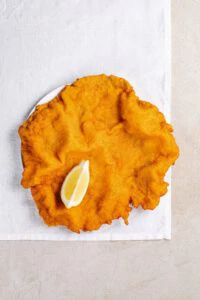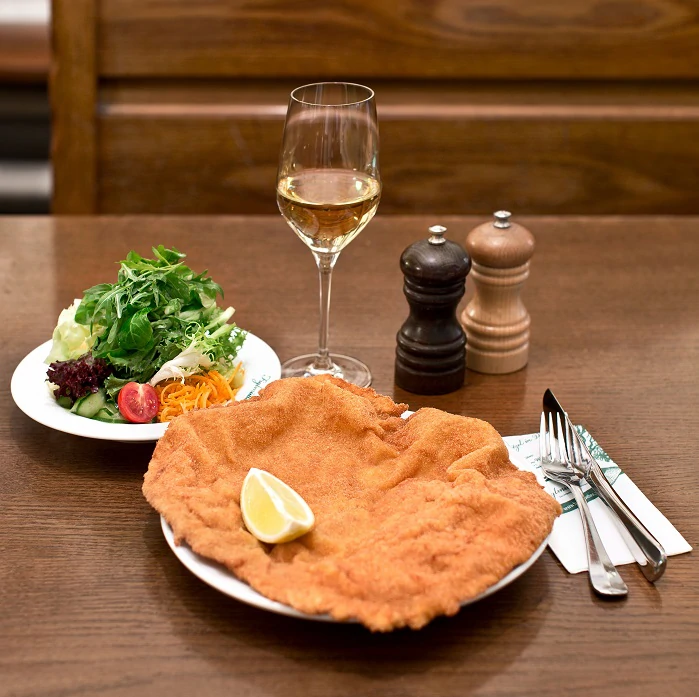What is special about the Figlmüller Schnitzel?
How is the Wiener Schnitzel prepared?
When can it be called Original Wiener Schnitzel?
What is the typical side dish?
Where can you find the Figlmüller in Vienna?
The story of the successful catering entrepreneur Johann Figlmüller began in 1905 .
Back then, he opened a small wine bar in Wollzeile, near St. Stephen’s Cathedral . His son of the same name, Hans, completed an apprenticeship as a waiter and attended courses in winemaking in Klosterneuburg.
helped the restaurant to international fame in the 1960s . Hans also founded Figls in Grinzing in 2004, which is dedicated to Viennese wine as well as Wiener Schnitzel .
Due to its great success, another Figlmüller restaurant was opened in Bäckerstraße in 2001.
You can also try Vienna’s largest schnitzel at Lugeck and at the airport .
The family business is now in its fourth generation.
The special thing about the Figlmüller Schnitzel is that it is the largest in Vienna and, with a diameter of 30 cm , protrudes over the edge of the plate.
It weighs around 250 grams. The finest pork is used, from the Karreerose . This is a high-quality back cut that hardly swells when fried in vegetable oil .
Three different pans are used for this, not a deep fryer. 
The meat has to be wafer-thin before it is dredged in flour and passed through a boiled egg.
Finally comes the breading, which consists of crumbs from Kaisersemmeln .
This makes the Figlmüller schnitzel particularly thin and crispy . A potato and lamb’s lettuce salad is served as a classic side dish.
A classic white wine, Grüner Veltliner, is an excellent accompaniment to the schnitzel.
Of course, the original Wiener Schnitzel is made from veal and can only be called that if it is.
Otherwise it is known as Viennese-style schnitzel .
In many households, the Wiener Schnitzel is traditionally prepared on Sundays and you can often hear the sound of the schnitzel knocking in the morning.
Traditionally, lard is also often used.
Figlmüller also serves the famous Wiener Tafelspitz for lovers of boiled beef with soup.
And then, of course, the traditional desserts of Viennese cuisine, such as apple strudel and Kaiserschmarrn. How did the Wiener Schnitzel come about? There are several theories. It possibly goes back to the cotoletta alla milanese in northern Italy and found its way to Vienna in the 15th century.
to Vienna, although this is not documented.
Another legend says that Field Marshal Radetzky brought the recipe back from Italy in 1857 , but this has been disproved.
Even before the Schnitzel, there were dishes in Vienna that were baked floating in fat, such as the popular fried chicken , which was first mentioned in a cookbook in 1719 .
The Wiener Schnitzel may have originated at the same time.
Another unconfirmed version is that a Byzantine princess is said to have brought the schnitzel to Vienna as early as the Babenberg period .
Whatever the exact origin of the Wiener Schnitzel, it is one of the most popular dishes in Austria, whether young or old.
No restaurant is complete without a Wiener Schnitzel.
Time Travel Tip: Be sure to make a reservation at Figlmüller, as the queue is always very long.
More info: Figlmüller Vienna ” The home of the original Wiener Schnitzel (figlmueller.at)




